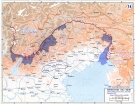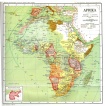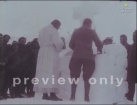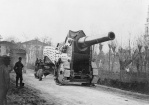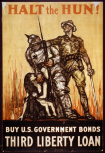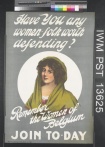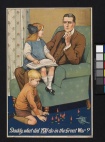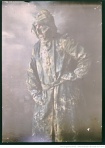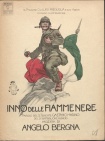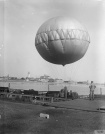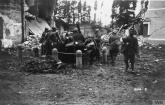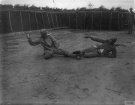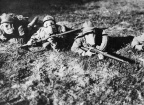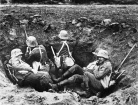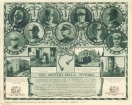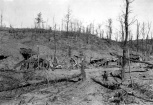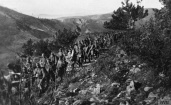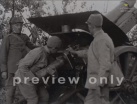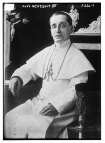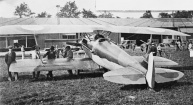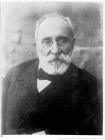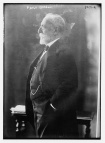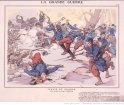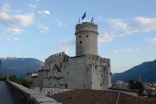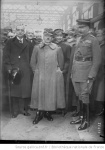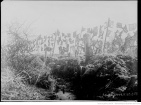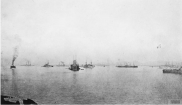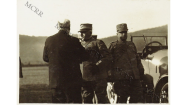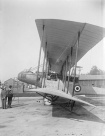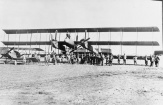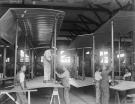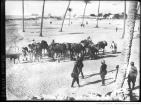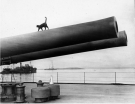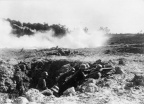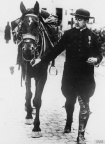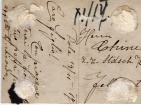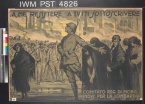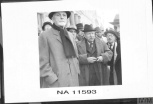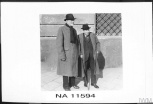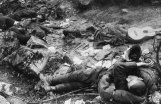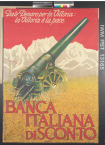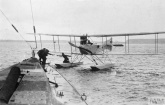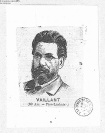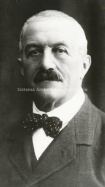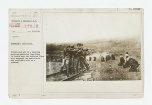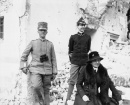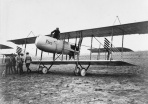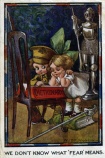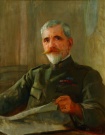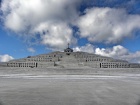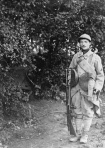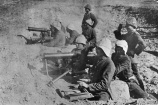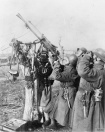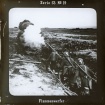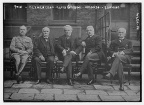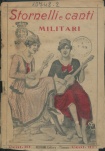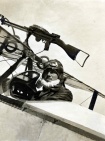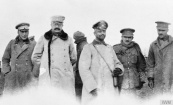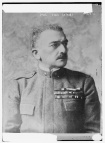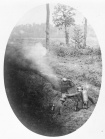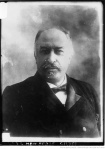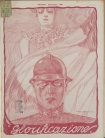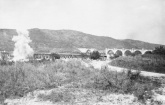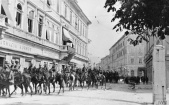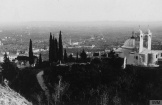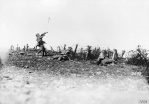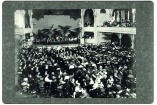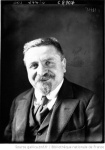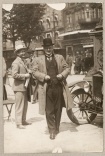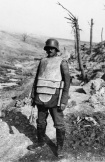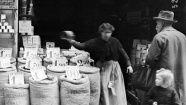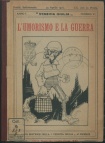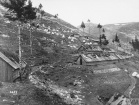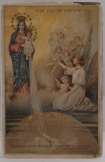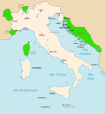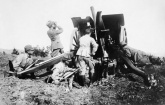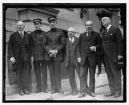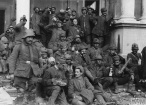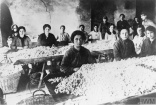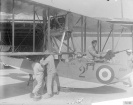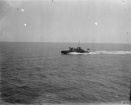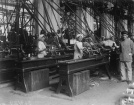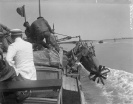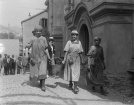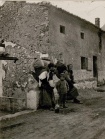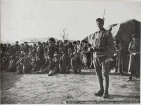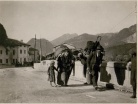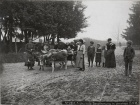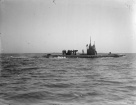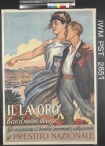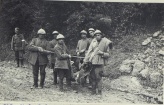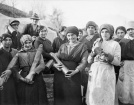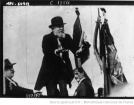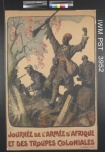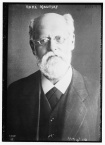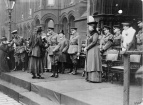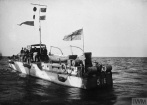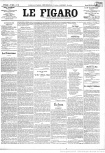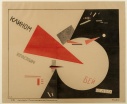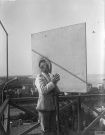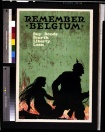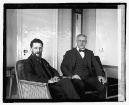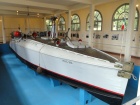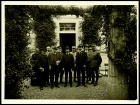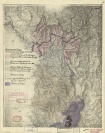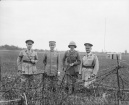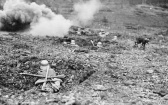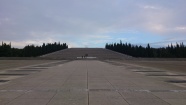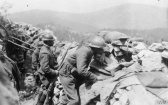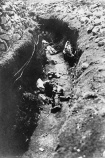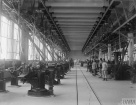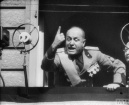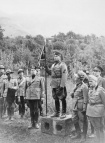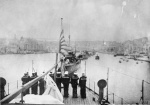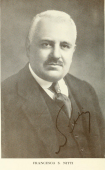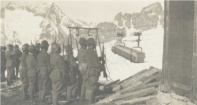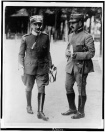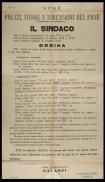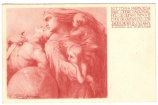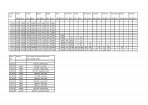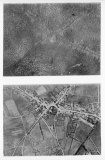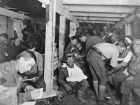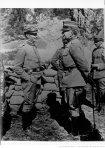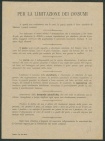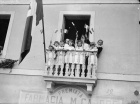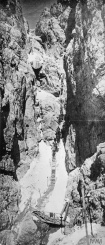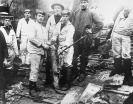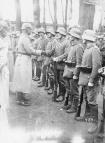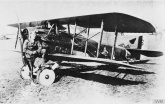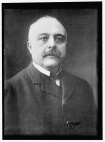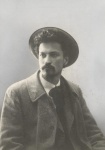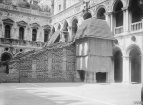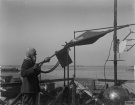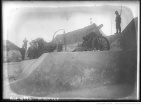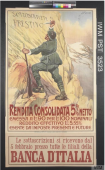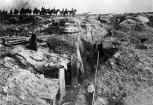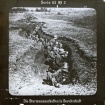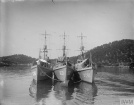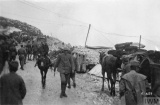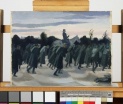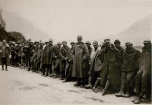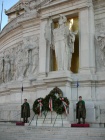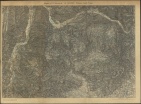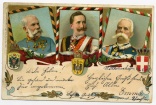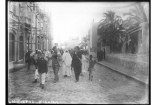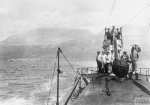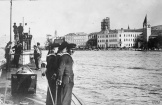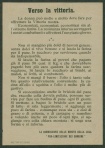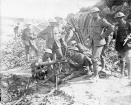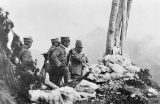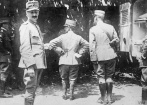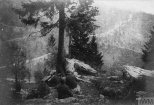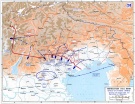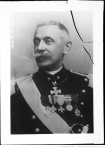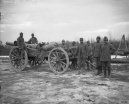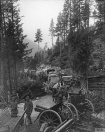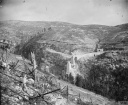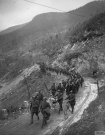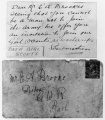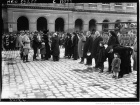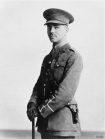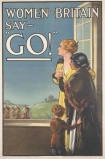Regions Italy
Survey Articles (Regional)
Regional Thematic Articles
- Air Warfare (Italy)
- Art (Italy)
- Between Acceptance and Refusal - Soldiers' Attitudes Towards War (Italy)
- Centenary (Italy)
- Children and War (Italy)
- Civilian and Military Power (Italy)
- Colonies (Italy)
- Discipline and Military Justice (Italy)
- Film/Cinema (Italy)
- Food and Nutrition (Italy)
- Governments, Parliaments and Parties (Italy)
- Historiography 1918-Today (Italy)
- Labour, Labour Movements, Trade Unions and Strikes (Italy)
- Literature (Italy)
- Making Sense of the War (Italy)
- Mourning and Cult of the Fallen (Italy)
- Occupation during and after the War (Austria-Hungary)
- Occupation during and after the War (Italy)
- Organization of War Economies: Industrial Mobilization (Italy)
- Post-war Economies (Italy)
- Post-war Societies (Italy)
- Press/Journalism (Italy)
- Pre-war Military Planning (Italy)
- Prisoners of War (Italy)
- Propaganda at Home (Italy)
- Refugees (Italy)
- Religious Mobilization and Popular Belief (Italy)
- Science and Technology (Italy)
- Social Conflict and Control, Protest and Repression (Italy)
- War Aims and War Aims Discussions (Italy)
- Warfare 1914-1918 (Italy)
- War Finance (Italy)
- War Letters (Italy)
- War Losses (Italy)
- Women's Mobilization for War (Italy)
Encyclopedic Entries
- Albertini, Luigi
- Arditi
- Attrition Warfare
- Baracca, Francesco
- Battisti, Cesare
- Bishops and Chaplains (Italy)
- Boselli, Paolo
- Cadorna, Luigi
- Camouflage
- Capello, Luigi
- Caporetto, Battle of
- Christmas Truce
- Croce, Benedetto
- D'Annunzio, Gabriele
- Diaz, Armando, Duke of Victory
- Empire
- Fear
- Feminist Pacifism
- Flamethrower
- Giardino, Gaetano Ettore
- Giolitti, Giovanni
- Gorizia, Battle of
- Interventionism (Italy)
- Isonzo, Battles of
- Italian Irredentism
- Italo-Turkish War 1911-1912
- London, Treaty of (1915)
- Machine Gun
- Masculinities
- Mediterranean Theater, Naval Operations
- Militarized Workers (Italy)
- Military Volunteers (Italy)
- Monte Grappa, Battle of
- Mussolini, Benito
- Naval Warfare (Italy)
- Nitti, Francesco Saverio
- Ojetti, Ugo
- Orlando, Vittorio Emanuele
- Orphans (Italy)
- Piave, Battles of
- Pope Benedict XV
- Pre-war Socialist Pacifism
- Rape
- Salandra, Antonio
- Sonnino, Sidney
- Stormtrooper
- Supreme War Council
- Tomb of the Unknown Soldier, Rome
- Trentino
- Victor Emmanuel III, King of Italy
- Vittoria Mutilata
- Vittorio Veneto, Battle of
- War and Comics (Italy)
- War in the Alps (Italy)
- War Poetry
- War Profiteers
- War Widows
See also
- Air Warfare
- Alliance System 1914
- Antisemitism
- Art
- Between Acceptance and Refusal - Soldiers' Attitudes Towards War
- Caricatures
- Censorship
- Centenary (Battlefield Tourism)
- Centenary (Computer Games)
- Centenary (Internet)
- Centenary (Visual Arts)
- Children and Youth
- Civilian and Military Power
- Civilian Morale
- Commemoration, Cult of the Fallen
- Controversy: Total War
- Demobilization
- Espionage
- Fascism and the Radical Right
- Film/Cinema
- Food and Nutrition
- Governments, Parliaments and Parties
- Health, Disease, Mortality; Demographic Effects
- Imperialism
- International Labour Organization
- International Law and the Laws of War
- Italian Front
- Labor
- Labour Movements, Trade Unions and Strikes
- League of Nations
- Militarism
- Military Justice
- Military Lessons of the First World War
- Moral Norms and Values
- Nationalism
- Naval Warfare
- Negotiating and Mediating Conduct of War
- Occupation during the War
- On the Road to Modern War
- Peace Initiatives
- Post-war Welfare Policies
- Prisoners of War
- Propaganda at Home and Abroad
- Property Rights and Economic Nationalism
- Raw Materials
- Refugees
- Religious Mobilization and Popular Belief
- Resettlement
- Revolutions
- Rural Society
- Schools and Universities
- Sea Transport and Supply
- Social Conflict
- Social Costs of War
- State, Civil Society and Relief Organizations for War
- The Churches
- The Everyday as Involved in War
- The Military Collapse of the Central Powers
- The Paris Peace Conference and its Consequences
- The Way to War
- Warfare 1914-1918
- War Finance
- Willingly to War. Public Response to the Outbreak of War
- Women’s Mobilization for War
- Women War Reporters
Regional Thematic Articles
-
Italy entered the war in 1915 with just a few dozen airplanes and more or less the same number of pilots, however, during the conflict, the accelerated development of the force made it necessary to … READ MORE
Regional Thematic -
The article demonstrates the significance of the Great War for Italian Futurism: an aesthetic war, technological but above all revolutionary, from which, for the Italian avant-garde, a new society … READ MORE
Regional Thematic -
During the First World War, Italian soldiers’ attitudes varied widely, from enthusiasm to outright rejection of military service thanks to diverse political opinions, socioeconomic backgrounds and … READ MORE
Regional Thematic -
This article illustrates the main characteristics of the long commemorative cycle dedicated to the centenary of the Great War in Italy and its success compared to other anniversaries of national and … READ MORE
Regional Thematic -
In Italy, as in all the belligerent countries, the First World War fully involved children and adolescents of both sexes. They witnessed and participated in the mobilization of parents, brothers and … READ MORE
Regional Thematic -
In Italy, as in the other European states involved in the First World War, the outbreak of hostilities saw extraordinary powers conferred upon the armed forces, so as to free them from the … READ MORE
Regional Thematic -
The Italian colonies, with the partial exception of Libya, played only a secondary role in the Great War. By virtue of not sharing borders with any German colonial territories, Italian overseas … READ MORE
Regional Thematic -
The article illustrates the soldiers’ attitudes to the war, highlighting both the inadequacy of the work of involving the combatants in the reasons for the conflict and the decision to deal with … READ MORE
Regional Thematic -
Italian cinema has tried with difficulty to exploit the narrative idealization of victory in the Great War. The film productions of the years of conflict (fictional and non-fictional) predictably … READ MORE
Regional Thematic -
During the First World War, the Italian government was unable to establish a realistic plan to feed the army and the civilian population; consequently there was a significant reduction in the … READ MORE
Regional Thematic -
During the period of neutrality, Italian public opinion was divided into two camps: one interventionist, and the other, in the majority, opposed to Italy’s entry into the war. Neutralism brought … READ MORE
Regional Thematic -
Italian historiography of the Great War has been deeply affected by the close link between historical studies and the climate of public opinion, which can be broken down into five major phases: the … READ MORE
Regional Thematic -
This article analyzes changes provoked by the war within the world of industrial labour (labour composition, production, work conditions, strikes and protests), and the effects of the policy adopted … READ MORE
Regional Thematic -
Literary activity in Italy during the Great War was based on a very wide range of genres and individual works the aesthetic value of which was highly varied. Nonetheless, in order fully to understand … READ MORE
Regional Thematic -
This article investigates the dimensions of meaning that Italian intellectuals either attributed to the “War of Redemption” of 1915-1918 or accordingly dismissed. The focal point is the dialectic … READ MORE
Regional Thematic -
For Italy, the mass death of soldiers in the First World War was a completely unprecedented experience. An enormous amount of time and effort were expended to cope with it. Assorted microcosms of … READ MORE
Regional Thematic -
While on the Western Front there were only limited territorial movements, the Eastern Front and warfare in southeastern Europe, including parts of Italy, had all the characteristics of mobile … READ MORE
Regional Thematic -
During and after the First World War, Italy experienced different kinds of occupation. The Italian occupation of the border areas in 1915-1917 was followed by the Austro-German occupation in … READ MORE
Regional Thematic -
Industrial mobilisation in Italy during the first World War took on particular characteristics as a result of the country’s reduced economic capacity. To respond to the challenges of the war, a … READ MORE
Regional Thematic -
Starting from the essential parameters of the Italian economy and finance in the post-war years, this article points out the similarities with the evolution of other capitalist economies, and the … READ MORE
Regional Thematic -
Post-war Italy was the only country that proved unable to use victory as a rhetorical device to consolidate its political system. Internal divisions rendered the old liberal ruling classes incapable … READ MORE
Regional Thematic -
Propaganda, combined with censorship, was indubitably one of the genuinely novel features of the First World War. The control over information assumed unprecedented dimensions and was put into effect … READ MORE
Regional Thematic -
From 1870 to 1914, given the inferiority of the Italian army with respect to that of the Habsburgs, Italian war plans maintained a defensive or counteroffensive posture. In the period of neutrality, … READ MORE
Regional Thematic -
In the first part of the article, the salient features of the experiences of the Italian prisoners of war are highlighted: the high number of soldiers captured and the high number of deaths among the … READ MORE
Regional Thematic -
The Italian government, in line with its liberal political views, left the material and spiritual mobilization, as well as domestic propaganda, under the control of bourgeois associations in the … READ MORE
Regional Thematic -
During World War I, about 630,000 people found refuge in the interior of the Kingdom of Italy. They left their homes for different reasons. Some of them were Italian citizens repatriated from … READ MORE
Regional Thematic -
This article summarizes the state of knowledge about the role of religions during the First World War in Italy, with particular reference to their presence in society, the trenches, and politics. … READ MORE
Regional Thematic -
This article analyzes the events which occurred in the Italian scientific world during the First World War. It investigates, in particular, the following aspects: the role of scientists as national … READ MORE
Regional Thematic -
In the years 1914-1918, Italy was the scene of periodic waves of protest against the war. The particular form the exceptional conditions took, and the mobilization were the cause and effect of social … READ MORE
Regional Thematic -
At the outbreak of the First World War, Italian diplomacy did not have a clear vision of the goals to be achieved. Therefore, in negotiations with the countries already involved in the conflict, … READ MORE
Regional Thematic -
The Italian Army faced the conflict in an inferior position compared to the opposing Austro-Hungarian forces which, in addition to skillfully exploiting the mountainous terrain for defensive … READ MORE
Regional Thematic -
Setting out from the fundamental variables of the Italian economy and finances on the eve of the war and during the years of conflict, this article highlights the country’s dependence on … READ MORE
Regional Thematic -
Despite the high rates of illiteracy in Italy on the eve of the war, the conflict brought about an unusual and massive recourse to writing, and not only by soldiers at the front. The correspondence … READ MORE
Regional Thematic -
The article examines the Italian losses in the Great War 1914-1918. Regarding the military, indications are given about the losses in relation to the population and the number of men mobilized, the … READ MORE
Regional Thematic -
The departure of millions of men for the front created unprecedented areas of action which Italian women could enter. The mobilization of women was accompanied by acceptance of, or, on the contrary, … READ MORE
Regional Thematic
Encyclopedic Entries
-
Luigi Albertini was a journalist and editor-in-chief of one of the most important Italian newspapers, ''Corriere della Sera''. From the pages of his newspaper, he advocated for Italian intervention … READ MORE
Entry -
''Arditi'' were elite assault troops in the Italian army. They also emerged on Italy’s post-war political scene thanks to newly formed associations. Even though many of them had ties to fascism, … READ MORE
Entry -
Attrition warfare is the term used to describe the sustained process of wearing down an opponent so as to force their physical collapse through continuous losses in personnel, equipment and supplies … READ MORE
Entry -
Francesco Baracca was the most famous Italian aviator, and shot down thirty-four enemy airplanes. He began his career in 1910 as a cavalry officer and became an air-fighter in 1912. He fought in the … READ MORE
Entry -
Cesare Battisti was the leader of the socialist party of the Italian Tirol (Trentino) and, from 1911, a member of the Austrian parliament. At the outbreak of war he went to Italy to engage in … READ MORE
Entry -
Italian bishops and chaplains played a central role in making sense of the war by presenting sacrifice for one’s country as an act of charity and brotherly love. In addition to the 2,624 Catholic … READ MORE
Entry -
After a long parliamentary career, Paolo Boselli became Italy’s 22nd prime minister in June 1916 after the fall of Antonio Salandra’s government. Charged with forming a unity … READ MORE
Entry -
Luigi Cadorna was a career military man, the son of a major general in the army of Piedmont. He quickly climbed the military hierarchy to become chief of staff of the Italian army from July 1914 … READ MORE
Entry -
A technique of concealment and protection, a means to deceive but not kill, camouflage was significantly developed during the First World War. The technique enabled many artists to put their talents … READ MORE
Entry -
Luigi Capello was an Italian general who took part in the war on the Gorizia front. As commander-in-chief of the Second Army, many held him to be chiefly to blame for the defeat of Caporetto. Having … READ MORE
Entry -
The Battle of Caporetto, also known as the Twelfth Battle of the Isonzo, remains the worst defeat suffered by the Italian army to date. It began at two o’clock in the morning on 24 October 1917 on … READ MORE
Entry -
In December 1914, there were several truces between enemy soldiers along one part of the Western front. Widely publicized, they underscore how difficult it was for soldiers to adapt to the conditions … READ MORE
Entry -
Benedetto Croce is an important figure for both Italian intellectual life (through his philosophical and historical writings) and the political history of Italy (through his work as a politician). … READ MORE
Entry -
One of Italy’s leading literary figures, Gabriele D’Annunzio agitated for Italian intervention in the war in 1915. After serving as a volunteer fighter pilot, he led a group of fellow … READ MORE
Entry -
Armando Diaz was an Italian officer and a general during World War I. In 1917, after the defeat of Caporetto, he replaced Luigi Cadorna as chief of general staff of the Italian army. He reformed the … READ MORE
Entry -
World War I was not simply a conflict among European states but a global war of empires. The fighting took place not only in Europe, but also in Africa, Asia, and across the Middle East, and it … READ MORE
Entry -
Fear
By Jan Plamper
Of the two world wars, the First World War was special in that fear figured prominently in a number of domains, including military tactics, psychiatry, and first-person sources. Fear was to be … READ MORE
Entry -
A minority section of the women’s movements opposed World War I and organized the International Congress of Women at The Hague in April 1915. Its participants demanded women’s rights and more … READ MORE
Entry -
The use of portable flamethrowers in combat was a First World War innovation. The German army took the lead in developing this form of warfare and remained the foremost practitioner of it throughout … READ MORE
Entry -
Gaetano Giardino was an Italian general best remembered for his role as commander of the Fourth Army, the army of the Grappa, and as minister of war during the parliamentary crisis of June 1917. In … READ MORE
Entry -
Giovanni Giolitti favored the increased liberalization of Italy, which encouraged its estrangement from the Triple Alliance. He consistently refused to recognize that Italy’s partners’ aggressive … READ MORE
Entry -
The Battle of Gorizia, known as the Sixth Isonzo’s Battle, was fought by the Italian Third Army against the Austro-Hungarian Fifth Army between 6 and 16 August 1916. It resulted in the Italian … READ MORE
Entry -
Italy entered the First World War in May 1915, roughly ten months after it began. During those ten months, the battle of opinions for and against intervention raged on. Public meetings, … READ MORE
Entry -
The battles of Isonzo represented Italy’s main offensive efforts against the Austro-Hungarian Empire during World War I. The eleven battles took place between 1915 and 1917 along the Isonzo River … READ MORE
Entry -
This article examines the history of Italian irredentism before 1915; and its place its role in Italy’s entry into the war in May 1915 and in Austro-Hungary’s military governance of the … READ MORE
Entry -
The Italo-Turkish War (1911-1912) took place mainly in Ottoman Libya following Italy’s invasion, not taking into consideration the fierce Ottoman and indigenous … READ MORE
Entry -
The Treaty of London was a secret agreement signed by Italy, Great Britain, France, and Russia on 26 April 1915, bringing Italy into the First World War on the Entente side. It therefore had a … READ MORE
Entry -
Between 1914 and 1918, the machine gun played an ever-increasing role on the battlefield. Today, even though artillery was responsible for the majority of deaths, the machine gun is the weapon most … READ MORE
Entry -
The First World War represents the apex of the ideal of the male warrior hero. Between 1914 and 1918, both the soldiers themselves and combatant societies relied upon gendered language to make sense … READ MORE
Entry -
The real naval war in the Mediterranean turned out to be a struggle against German and Austrian submarines and not a classic battle between major … READ MORE
Entry -
In 1915 the Italian government created an agency called ''Mobilitazione Industriale'' (Industrial Mobilisation) to manage economic activities and labour relations in wartime. The MI attempted to … READ MORE
Entry -
The history of the Italian military volunteers concerns not only the roughly 10,000 men who chose to fight without (or before) being drafted, but also the approximately 6,000 Italians who served in … READ MORE
Entry -
After the battle of Caporetto, the Austro-German army launched several attacks against Mount Grappa to break through the Italian line. The battle was fought in two phases: between 13 and 26 November, … READ MORE
Entry -
Italian Socialist Benito Mussolini envisioned war as the prerequisite for revolution. He helped push Italy into World War I. After combat service and medical discharge in 1917, he demanded war until … READ MORE
Entry -
Italy’s war at sea reflected the more general trends of the naval warfare in the Great War: a stalemate that turned into a war of naval attrition. Only after harsh losses to national shipping and … READ MORE
Entry -
Francesco Nitti was minister of the Treasury in the Orlando Cabinet after the defeat of Caporetto in 1917 and prime minister of Italy in 1919. During his mandate he signed the treaty of … READ MORE
Entry -
Ugo Ojetti was a journalist who, during the war, was tasked with the protection of monuments and artworks in the Italian-occupied territories. He was also instrumental in establishing and managing … READ MORE
Entry -
A renowned jurist with lasting influence, Vittorio Emanuele Orlando served as justice and interior minister between 1916 and 1917, implementing liberal policies despite strong opposition. As prime … READ MORE
Entry -
This article focuses on the efforts of the Italian government and certain institutions to care for the high numbers of war orphans in the country. In addition to a brief reconstruction of the … READ MORE
Entry -
The two battles of the River Piave were fought between 10 November and 25 December 1917, and 15-23 June 1918, respectively. The Austro-Hungarian army, supported by German units, tried to bring about … READ MORE
Entry -
Much of the reign of Pope Benedict XV was dominated by the First World War. Pope Benedict deplored this war and thus, together with his Secretary of State, he tried to bring an end to it through … READ MORE
Entry -
The Socialists’ opposition to war in France, Germany and Italy during the period of the Second International (1889-1914) was contradictory. They tried to combine internationalism, antiwar … READ MORE
Entry -
Although rape was not usually systematic, it occurred frequently on all fronts during the First World War, during both invasion and occupation periods. It was often used in propaganda to discredit … READ MORE
Entry -
Antonio Salandra was an important Italian politician in the early 20th century. When the Great War broke out, he was prime minister of Italy and had a decisive yet controversial role in … READ MORE
Entry -
Sidney Sonnino was the Italian Minister of Foreign Affairs during World War I. He negotiated the Treaty of London, defining the terms with which Italy would enter into the war alongside the Triple … READ MORE
Entry -
Storm troopers were soldiers in specialized assault units, which emerged in the German army during the First World … READ MORE
Entry -
The Supreme War Council was an Allied administrative organisation, created by the Entente governments in November 1917 to coordinate their military action. Its most significant achievement was to … READ MORE
Entry -
At the end of the Great War, many countries determined that they would bury an anonymous corpse to symbolize all those who died on the battlefields. In Italy, the ceremony for the entombment of the … READ MORE
Entry -
Trentino
By Nicola Fontana and Mirko Saltori
Trentino is an Italian-speaking region which was the southernmost part of the Tyrol. With Italy’s entry into the war, it found itself in the front area. After the war it was annexed to the Kingdom … READ MORE
Entry -
Victor Emmanuel III played an important, if often overlooked part in Italy’s decision to intervene in World War I on the side of the Entente. During the war, he managed to solve two political … READ MORE
Entry -
Gabriele D’Annunzio’s phrase “mutilated victory” infers that Italy’s wartime sacrifices went unrewarded, but excessive Italian demands and inept diplomacy in Paris provoked French and … READ MORE
Entry -
The Battle of Vittorio Veneto was fought between 24 October and 4 November 1918 by the Italian 4th, 8th, 10th and 12th Armies against the Austro-Hungarian … READ MORE
Entry -
Comics played a very important role in the total mobilization in Italy. Firstly in the cities and then in the trenches, they were a new propaganda tool and explanation of the war for children and … READ MORE
Entry -
This article examines the concept of war poetry and considers the range of poetic responses generated by the Great War from an international … READ MORE
Entry -
As a long-lasting industrial war, the Great War led to the realization of considerable profits throughout industrialized countries. Both real and imagined, they structured many wartime facets, from … READ MORE
Entry -
One third of the 9.7 million soldiers killed or declared missing during the Great War left behind a widow. The mourning of these women was conditioned as much by the social conventions practiced … READ MORE
Entry
See also
-
Air Warfare
By Ross Mahoney and James Pugh
This article considers the use and evolution of air power during the First World War. By focusing on the principal air power roles – control of the air, tactical, strategic, and naval and maritime … READ MORE
Thematic -
Alliances were an important feature of the international system on the eve of World War I. The formation of rival blocs of Great Powers has previously considered a major cause of the outbreak of war … READ MORE
Thematic -
The First World War and its direct repercussions in the postwar period (revolution, counterrevolution, the founding of republics, and the Paris peace treaties) mark a profound caesura not only in the … READ MORE
Thematic -
Art
By Sue Malvern
The nature of the First World War put an end to traditions for battle painting. Instead, war art by younger more progressive artists was the best received because it was judged the most authentic. … READ MORE
Thematic -
Soldiers’ attitudes towards the Great War are a controversial issue, as they prove difficult to assess and raise complex methodological questions. They evolved during the course of the conflict, … READ MORE
Thematic -
This article presents cartoonists as patriotic propagandists mobilizing their pens and brushes for the national cause during the war. It analyses their techniques for arousing emotions such as … READ MORE
Thematic -
Censorship was an indispensable war weapon: its task was to keep the people in an atmosphere of utter ignorance and unshaken confidence in the authorities, and to allow their boundless indoctrination … READ MORE
Thematic -
The centenary of the First World War has been a catalyst for battlefield tourism. The creation of new museums, memorials, statues, commemorative trails and the like has strengthened the Great War’s … READ MORE
Thematic -
The First World War centenary saw an emergence of new portrayals of the conflict in computer games. These new games sought either to tell new stories of war and conflict during the time period or to … READ MORE
Thematic -
The centenary events surrounding the First World War have produced a significant amount of digital content in various forms, and thus has set a precedent for how large scale post-war memorisation can … READ MORE
Thematic -
The commemorative period between 2014 and 2018 was marked globally by numerous exhibitions of original artworks that had been commissioned and created during and immediately after World War 1. Most … READ MORE
Thematic -
Mass conscription recast relationships in families, raised minors’ potential as wage earners, and decreased supervision over them. War ravaged the health of young people in Central Europe while … READ MORE
Thematic -
By 1914 the leading states had succumbed to varying degrees of militarism, subordinating other interests to those of the armed forces, yet all were governed by regimes in which the ultimate authority … READ MORE
Thematic -
This article deals with civilian morale during the First World War. Between 1915 and 1918, governments “discovered” the importance of civilian morale and developed vast systems of surveillance to … READ MORE
Thematic -
The First World War ushered in an unprecedented wave of commemorations. Mass death elicited a construction spree in memorial objects and sites across all countries and territories involved in the … READ MORE
Thematic -
Total war is a controversial term used in the past by politicians, publicists and military officers as well as by computer specialists and academics in the present. Since its conception by French … READ MORE
Thematic -
The end of fighting in 1918 raised hopes for swift and equitable military demobilization amongst soldiers and civilians. The timing and nature of demobilization varied greatly, though, due to … READ MORE
Thematic -
During the entire war, warring powers used the “secret war” to try to break the balance of the battlefield. Generally created in the previous few decades, intelligence and security services saw … READ MORE
Thematic -
The First World War was not only the precondition of the rise of fascist movements in a general way: more definitely, the fascists presented themselves as the heirs of the trench combatants. German … READ MORE
Thematic -
The First World War played a significant role in the evolution of film both as a medium for reporting war and as a tool for the propagandist manipulation of public opinion to support the war effort. … READ MORE
Thematic -
During the First World War, food became a major issue for military and civilian matters. This contribution aims to discuss the food situation in the belligerent countries in connection with global … READ MORE
Thematic -
One sees a wide range of political regimes from a democratic republic with universal male suffrage (France) to parliamentary, constitutional, or even oligarchical monarchies in the countries that … READ MORE
Thematic -
The rapid spread of epidemics ravaged military personnel and civilians in and outside Europe’s warzones during the Great War. Further, the great influenza pandemic of 1918-1919 became a global … READ MORE
Thematic -
This article focuses on the extent to which imperialism contributed to the outbreak of the First World War. The first part describes the emergence of specific imperialist cultures and attitudes in … READ MORE
Thematic -
The Treaty of Versailles was signed on 28 June 1919, establishing both the League of Nations and another international organization: the International Labour Organization (ILO). The ILO was founded … READ MORE
Thematic -
The article examines international efforts to curb states’ war-making prerogatives in the second half of the “long” 19th century. It captures new humanitarian sentiments circulating … READ MORE
Thematic -
In May 1915, Italy attacked Austria-Hungary along the Isonzo River and in the Trentino, hoping to conquer territory which it believed to be rightfully Italian. An immobile, entrenched war of … READ MORE
Thematic -
Across the major belligerent powers, industrial production and the mobilization and organization of industrial labor became central to the conduct of the First World War. States and private … READ MORE
Thematic -
This article compares the history of labour movements during the war across a range of European countries. It charts the impact of the economic realities of the war upon labour and analyses the … READ MORE
Thematic -
Militarism is a vague term that has meant different things to different people at different times. It can be analysed as a popular phenomenon, or as a feature more at home in the halls of power, or … READ MORE
Thematic -
This essay offers a comparative survey of the practice of military justice among several of the key belligerent powers. Accused soldiers enjoyed little in the way of legal protection, and punishment … READ MORE
Thematic -
This article examines the lessons derived by the military organizations that participated in the First World War on land, at sea, and in the air. It demonstrates that while military and naval … READ MORE
Thematic -
Change and continuity marked belligerent societies’ norms and values during the First World War. Normative institutions such as marriage and the family proved basically resilient but … READ MORE
Thematic -
This article offers an overview of the progress of nationalism and the national idea starting with its origins as a mass political programme during the French Revolution and tracing its passage up to … READ MORE
Thematic -
All of the great belligerent states of World War I were naval powers and engaged in operations around the globe. While the course of the war did not unfold as predicted by naval officials, it did … READ MORE
Thematic -
Many issues surrounding the conduct of war in the years 1914-1918 were impervious to international negotiation or mediation, due either to a complete lack of consensus or to an absence of trust and … READ MORE
Thematic -
After an initial wave of interest in 1914 and the immediate post-war period, international historiography long neglected the wartime occupation of territories inhabited by large civilian populations. … READ MORE
Thematic -
The Great War was never considered the “war to end all wars” by the states and armed forces in conflict. The war’s legacies were processed in a wide variety of ways depending on forms of … READ MORE
Thematic -
This paper examines major peace initiatives during World War I. It describes efforts by the chief European belligerents to split apart enemy coalitions with separate peace settlements as well … READ MORE
Thematic -
The Great War gave new impulses to the further development of public welfare systems which had emerged in previous decades. The desire for the social protection of the population and the restoration … READ MORE
Thematic -
The First World War marked the shift from a 19th century, relatively ''ad hoc'' management of prisoners of war, to the 20th century’s sophisticated prisoner of war camp … READ MORE
Thematic -
This article summarizes and compares the principal arguments and strategies of propaganda at the home front, the military front, as well as in neutral and enemy countries. These included the … READ MORE
Thematic -
This article explores the policies adopted and implemented against enemy property from the beginning of the Great War to the signing of the peace treaties in Europe. Breaking a long-standing … READ MORE
Thematic -
Raw materials were vital during the First World War. Due to the armaments production, the belligerents’ needs increased significantly, while the available resources fell. Each country intended both … READ MORE
Thematic -
This article addresses the scale of wartime population displacement in continental Europe, the relief efforts made on behalf of refugees, their impact on host communities, and the cultural … READ MORE
Thematic -
From the cradle to the grave, popular religion formed a necessary and vital, if analytically messy, part of the human experience of the Great War. The war had the potential to atomize and alienate … READ MORE
Thematic -
The conduct of warfare in 1914-1918 included extensive population resettlement in all theatres of war in Europe, both as a result of pre-emptive decisions by civilians to flee in order to evade the … READ MORE
Thematic -
This article surveys the various movements toward social, national, and political revolution that emerged during and in the wake of World War I. The Russian revolutions of 1917 serve as the first … READ MORE
Thematic -
The paper describes the impact of war on peasantry and its mobilisation in the war effort. While observers portrayed the countryside as rich and callous towards urban shortages or waging war, the … READ MORE
Thematic -
The military service of teachers and the mobilization of schoolchildren for voluntary war work deeply disrupted schooling, especially in Central Europe. In continental Europe, war infused curricula … READ MORE
Thematic -
Allied capacity at sea to sustain global transport and supply determined their ability to prevail in the First World War. The deployment of convoys to triumph over submarine warfare was an important … READ MORE
Thematic -
This article deals with the nature of social conflict during the war. The length of the conflict and growing food shortages on the home front strained relations between individuals and between social … READ MORE
Thematic -
This article explores how the anticipation, reality, and memory of sacrifice informed experiences and legacies of World War I. Drawing on representative examples from multiple nations, I suggest that … READ MORE
Thematic -
A vast array of initiatives designed to counteract the destructiveness of the First World War was developed by states and societies across the world. Protecting the bodies and minds of soldiers from … READ MORE
Thematic -
Reflecting current historiography, this article focuses primarily on Christian churches centered in the main European theater of the Great War, including more global interactions with the other … READ MORE
Thematic -
This essay examines how the "everyday" functions in war, not only for those on the home fronts, but for those in combat roles and for those living between the lines. Five important qualities, among … READ MORE
Thematic -
October 1918 witnessed the collapse of the German and Austro-Hungarian armies, both greatly affected by war-weariness and starvation. The Austro-Hungarian monarchy lost any remaining loyalty from its … READ MORE
Thematic -
This article offers an overview of peacemaking after the First World War from the armistices of 1918 until 1923. It considers the outcomes of the five Parisian treaties (Versailles, Saint-Germain and … READ MORE
Thematic -
Imperialism shaped almost every facet of international politics from 1898 to 1914. Imperial concerns brought Britain into entente relationships with France and Russia. This Triple Entente often … READ MORE
Thematic -
Static “trench warfare” belied a dynamic transformation in warfare between 1914 and 1918. Every army grappled with the same issues: how to end a strategic stalemate occasioned by their ability to … READ MORE
Thematic -
The Great War required war-making states to mobilize and sustain the financial resources for a global war on an unprecedented scale. What made war finance during the conflict so special is that this … READ MORE
Thematic -
It may surprise us to learn that some sectors of the European public were in favour of the war in 1914. The impact of modern weapons was not well understood and many people in the government, … READ MORE
Thematic -
This article explores women’s economic, social, and political responses to the First World War. It addresses their mobilization including their engagement with the war effort as well as their … READ MORE
Thematic -
Female war reporters from belligerent and neutral countries were present in the major war theatres in Europe and the Middle East throughout 1914 to 1918. While admission of journalists to the war … READ MORE
Thematic
Regional Thematic Articles
-
Italy entered the war in 1915 with just a few dozen airplanes and more or less the same number of pilots, however, during the conflict, the accelerated development of the force made it necessary to … READ MORE
Regional Thematic -
The article demonstrates the significance of the Great War for Italian Futurism: an aesthetic war, technological but above all revolutionary, from which, for the Italian avant-garde, a new society … READ MORE
Regional Thematic -
During the First World War, Italian soldiers’ attitudes varied widely, from enthusiasm to outright rejection of military service thanks to diverse political opinions, socioeconomic backgrounds and … READ MORE
Regional Thematic -
This article illustrates the main characteristics of the long commemorative cycle dedicated to the centenary of the Great War in Italy and its success compared to other anniversaries of national and … READ MORE
Regional Thematic -
In Italy, as in all the belligerent countries, the First World War fully involved children and adolescents of both sexes. They witnessed and participated in the mobilization of parents, brothers and … READ MORE
Regional Thematic -
In Italy, as in the other European states involved in the First World War, the outbreak of hostilities saw extraordinary powers conferred upon the armed forces, so as to free them from the … READ MORE
Regional Thematic -
The Italian colonies, with the partial exception of Libya, played only a secondary role in the Great War. By virtue of not sharing borders with any German colonial territories, Italian overseas … READ MORE
Regional Thematic -
The article illustrates the soldiers’ attitudes to the war, highlighting both the inadequacy of the work of involving the combatants in the reasons for the conflict and the decision to deal with … READ MORE
Regional Thematic -
Italian cinema has tried with difficulty to exploit the narrative idealization of victory in the Great War. The film productions of the years of conflict (fictional and non-fictional) predictably … READ MORE
Regional Thematic -
During the First World War, the Italian government was unable to establish a realistic plan to feed the army and the civilian population; consequently there was a significant reduction in the … READ MORE
Regional Thematic -
During the period of neutrality, Italian public opinion was divided into two camps: one interventionist, and the other, in the majority, opposed to Italy’s entry into the war. Neutralism brought … READ MORE
Regional Thematic -
Italian historiography of the Great War has been deeply affected by the close link between historical studies and the climate of public opinion, which can be broken down into five major phases: the … READ MORE
Regional Thematic -
This article analyzes changes provoked by the war within the world of industrial labour (labour composition, production, work conditions, strikes and protests), and the effects of the policy adopted … READ MORE
Regional Thematic -
Literary activity in Italy during the Great War was based on a very wide range of genres and individual works the aesthetic value of which was highly varied. Nonetheless, in order fully to understand … READ MORE
Regional Thematic -
This article investigates the dimensions of meaning that Italian intellectuals either attributed to the “War of Redemption” of 1915-1918 or accordingly dismissed. The focal point is the dialectic … READ MORE
Regional Thematic -
For Italy, the mass death of soldiers in the First World War was a completely unprecedented experience. An enormous amount of time and effort were expended to cope with it. Assorted microcosms of … READ MORE
Regional Thematic -
While on the Western Front there were only limited territorial movements, the Eastern Front and warfare in southeastern Europe, including parts of Italy, had all the characteristics of mobile … READ MORE
Regional Thematic -
During and after the First World War, Italy experienced different kinds of occupation. The Italian occupation of the border areas in 1915-1917 was followed by the Austro-German occupation in … READ MORE
Regional Thematic -
Industrial mobilisation in Italy during the first World War took on particular characteristics as a result of the country’s reduced economic capacity. To respond to the challenges of the war, a … READ MORE
Regional Thematic -
Starting from the essential parameters of the Italian economy and finance in the post-war years, this article points out the similarities with the evolution of other capitalist economies, and the … READ MORE
Regional Thematic -
Post-war Italy was the only country that proved unable to use victory as a rhetorical device to consolidate its political system. Internal divisions rendered the old liberal ruling classes incapable … READ MORE
Regional Thematic -
Propaganda, combined with censorship, was indubitably one of the genuinely novel features of the First World War. The control over information assumed unprecedented dimensions and was put into effect … READ MORE
Regional Thematic -
From 1870 to 1914, given the inferiority of the Italian army with respect to that of the Habsburgs, Italian war plans maintained a defensive or counteroffensive posture. In the period of neutrality, … READ MORE
Regional Thematic -
In the first part of the article, the salient features of the experiences of the Italian prisoners of war are highlighted: the high number of soldiers captured and the high number of deaths among the … READ MORE
Regional Thematic -
The Italian government, in line with its liberal political views, left the material and spiritual mobilization, as well as domestic propaganda, under the control of bourgeois associations in the … READ MORE
Regional Thematic -
During World War I, about 630,000 people found refuge in the interior of the Kingdom of Italy. They left their homes for different reasons. Some of them were Italian citizens repatriated from … READ MORE
Regional Thematic -
This article summarizes the state of knowledge about the role of religions during the First World War in Italy, with particular reference to their presence in society, the trenches, and politics. … READ MORE
Regional Thematic -
This article analyzes the events which occurred in the Italian scientific world during the First World War. It investigates, in particular, the following aspects: the role of scientists as national … READ MORE
Regional Thematic -
In the years 1914-1918, Italy was the scene of periodic waves of protest against the war. The particular form the exceptional conditions took, and the mobilization were the cause and effect of social … READ MORE
Regional Thematic -
At the outbreak of the First World War, Italian diplomacy did not have a clear vision of the goals to be achieved. Therefore, in negotiations with the countries already involved in the conflict, … READ MORE
Regional Thematic -
The Italian Army faced the conflict in an inferior position compared to the opposing Austro-Hungarian forces which, in addition to skillfully exploiting the mountainous terrain for defensive … READ MORE
Regional Thematic -
Setting out from the fundamental variables of the Italian economy and finances on the eve of the war and during the years of conflict, this article highlights the country’s dependence on … READ MORE
Regional Thematic -
Despite the high rates of illiteracy in Italy on the eve of the war, the conflict brought about an unusual and massive recourse to writing, and not only by soldiers at the front. The correspondence … READ MORE
Regional Thematic -
The article examines the Italian losses in the Great War 1914-1918. Regarding the military, indications are given about the losses in relation to the population and the number of men mobilized, the … READ MORE
Regional Thematic -
The departure of millions of men for the front created unprecedented areas of action which Italian women could enter. The mobilization of women was accompanied by acceptance of, or, on the contrary, … READ MORE
Regional Thematic
Encyclopedic Entries
-
Luigi Albertini was a journalist and editor-in-chief of one of the most important Italian newspapers, ''Corriere della Sera''. From the pages of his newspaper, he advocated for Italian intervention … READ MORE
Entry -
''Arditi'' were elite assault troops in the Italian army. They also emerged on Italy’s post-war political scene thanks to newly formed associations. Even though many of them had ties to fascism, … READ MORE
Entry -
Attrition warfare is the term used to describe the sustained process of wearing down an opponent so as to force their physical collapse through continuous losses in personnel, equipment and supplies … READ MORE
Entry -
Francesco Baracca was the most famous Italian aviator, and shot down thirty-four enemy airplanes. He began his career in 1910 as a cavalry officer and became an air-fighter in 1912. He fought in the … READ MORE
Entry -
Cesare Battisti was the leader of the socialist party of the Italian Tirol (Trentino) and, from 1911, a member of the Austrian parliament. At the outbreak of war he went to Italy to engage in … READ MORE
Entry -
Italian bishops and chaplains played a central role in making sense of the war by presenting sacrifice for one’s country as an act of charity and brotherly love. In addition to the 2,624 Catholic … READ MORE
Entry -
After a long parliamentary career, Paolo Boselli became Italy’s 22nd prime minister in June 1916 after the fall of Antonio Salandra’s government. Charged with forming a unity … READ MORE
Entry -
Luigi Cadorna was a career military man, the son of a major general in the army of Piedmont. He quickly climbed the military hierarchy to become chief of staff of the Italian army from July 1914 … READ MORE
Entry -
A technique of concealment and protection, a means to deceive but not kill, camouflage was significantly developed during the First World War. The technique enabled many artists to put their talents … READ MORE
Entry -
Luigi Capello was an Italian general who took part in the war on the Gorizia front. As commander-in-chief of the Second Army, many held him to be chiefly to blame for the defeat of Caporetto. Having … READ MORE
Entry -
The Battle of Caporetto, also known as the Twelfth Battle of the Isonzo, remains the worst defeat suffered by the Italian army to date. It began at two o’clock in the morning on 24 October 1917 on … READ MORE
Entry -
In December 1914, there were several truces between enemy soldiers along one part of the Western front. Widely publicized, they underscore how difficult it was for soldiers to adapt to the conditions … READ MORE
Entry -
Benedetto Croce is an important figure for both Italian intellectual life (through his philosophical and historical writings) and the political history of Italy (through his work as a politician). … READ MORE
Entry -
One of Italy’s leading literary figures, Gabriele D’Annunzio agitated for Italian intervention in the war in 1915. After serving as a volunteer fighter pilot, he led a group of fellow … READ MORE
Entry -
Armando Diaz was an Italian officer and a general during World War I. In 1917, after the defeat of Caporetto, he replaced Luigi Cadorna as chief of general staff of the Italian army. He reformed the … READ MORE
Entry -
World War I was not simply a conflict among European states but a global war of empires. The fighting took place not only in Europe, but also in Africa, Asia, and across the Middle East, and it … READ MORE
Entry -
Fear
By Jan Plamper
Of the two world wars, the First World War was special in that fear figured prominently in a number of domains, including military tactics, psychiatry, and first-person sources. Fear was to be … READ MORE
Entry -
A minority section of the women’s movements opposed World War I and organized the International Congress of Women at The Hague in April 1915. Its participants demanded women’s rights and more … READ MORE
Entry -
The use of portable flamethrowers in combat was a First World War innovation. The German army took the lead in developing this form of warfare and remained the foremost practitioner of it throughout … READ MORE
Entry -
Gaetano Giardino was an Italian general best remembered for his role as commander of the Fourth Army, the army of the Grappa, and as minister of war during the parliamentary crisis of June 1917. In … READ MORE
Entry -
Giovanni Giolitti favored the increased liberalization of Italy, which encouraged its estrangement from the Triple Alliance. He consistently refused to recognize that Italy’s partners’ aggressive … READ MORE
Entry -
The Battle of Gorizia, known as the Sixth Isonzo’s Battle, was fought by the Italian Third Army against the Austro-Hungarian Fifth Army between 6 and 16 August 1916. It resulted in the Italian … READ MORE
Entry -
Italy entered the First World War in May 1915, roughly ten months after it began. During those ten months, the battle of opinions for and against intervention raged on. Public meetings, … READ MORE
Entry -
The battles of Isonzo represented Italy’s main offensive efforts against the Austro-Hungarian Empire during World War I. The eleven battles took place between 1915 and 1917 along the Isonzo River … READ MORE
Entry -
This article examines the history of Italian irredentism before 1915; and its place its role in Italy’s entry into the war in May 1915 and in Austro-Hungary’s military governance of the … READ MORE
Entry -
The Italo-Turkish War (1911-1912) took place mainly in Ottoman Libya following Italy’s invasion, not taking into consideration the fierce Ottoman and indigenous … READ MORE
Entry -
The Treaty of London was a secret agreement signed by Italy, Great Britain, France, and Russia on 26 April 1915, bringing Italy into the First World War on the Entente side. It therefore had a … READ MORE
Entry -
Between 1914 and 1918, the machine gun played an ever-increasing role on the battlefield. Today, even though artillery was responsible for the majority of deaths, the machine gun is the weapon most … READ MORE
Entry -
The First World War represents the apex of the ideal of the male warrior hero. Between 1914 and 1918, both the soldiers themselves and combatant societies relied upon gendered language to make sense … READ MORE
Entry -
The real naval war in the Mediterranean turned out to be a struggle against German and Austrian submarines and not a classic battle between major … READ MORE
Entry -
In 1915 the Italian government created an agency called ''Mobilitazione Industriale'' (Industrial Mobilisation) to manage economic activities and labour relations in wartime. The MI attempted to … READ MORE
Entry -
The history of the Italian military volunteers concerns not only the roughly 10,000 men who chose to fight without (or before) being drafted, but also the approximately 6,000 Italians who served in … READ MORE
Entry -
After the battle of Caporetto, the Austro-German army launched several attacks against Mount Grappa to break through the Italian line. The battle was fought in two phases: between 13 and 26 November, … READ MORE
Entry -
Italian Socialist Benito Mussolini envisioned war as the prerequisite for revolution. He helped push Italy into World War I. After combat service and medical discharge in 1917, he demanded war until … READ MORE
Entry -
Italy’s war at sea reflected the more general trends of the naval warfare in the Great War: a stalemate that turned into a war of naval attrition. Only after harsh losses to national shipping and … READ MORE
Entry -
Francesco Nitti was minister of the Treasury in the Orlando Cabinet after the defeat of Caporetto in 1917 and prime minister of Italy in 1919. During his mandate he signed the treaty of … READ MORE
Entry -
Ugo Ojetti was a journalist who, during the war, was tasked with the protection of monuments and artworks in the Italian-occupied territories. He was also instrumental in establishing and managing … READ MORE
Entry -
A renowned jurist with lasting influence, Vittorio Emanuele Orlando served as justice and interior minister between 1916 and 1917, implementing liberal policies despite strong opposition. As prime … READ MORE
Entry -
This article focuses on the efforts of the Italian government and certain institutions to care for the high numbers of war orphans in the country. In addition to a brief reconstruction of the … READ MORE
Entry -
The two battles of the River Piave were fought between 10 November and 25 December 1917, and 15-23 June 1918, respectively. The Austro-Hungarian army, supported by German units, tried to bring about … READ MORE
Entry -
Much of the reign of Pope Benedict XV was dominated by the First World War. Pope Benedict deplored this war and thus, together with his Secretary of State, he tried to bring an end to it through … READ MORE
Entry -
The Socialists’ opposition to war in France, Germany and Italy during the period of the Second International (1889-1914) was contradictory. They tried to combine internationalism, antiwar … READ MORE
Entry -
Although rape was not usually systematic, it occurred frequently on all fronts during the First World War, during both invasion and occupation periods. It was often used in propaganda to discredit … READ MORE
Entry -
Antonio Salandra was an important Italian politician in the early 20th century. When the Great War broke out, he was prime minister of Italy and had a decisive yet controversial role in … READ MORE
Entry -
Sidney Sonnino was the Italian Minister of Foreign Affairs during World War I. He negotiated the Treaty of London, defining the terms with which Italy would enter into the war alongside the Triple … READ MORE
Entry -
Storm troopers were soldiers in specialized assault units, which emerged in the German army during the First World … READ MORE
Entry -
The Supreme War Council was an Allied administrative organisation, created by the Entente governments in November 1917 to coordinate their military action. Its most significant achievement was to … READ MORE
Entry -
At the end of the Great War, many countries determined that they would bury an anonymous corpse to symbolize all those who died on the battlefields. In Italy, the ceremony for the entombment of the … READ MORE
Entry -
Trentino
By Nicola Fontana and Mirko Saltori
Trentino is an Italian-speaking region which was the southernmost part of the Tyrol. With Italy’s entry into the war, it found itself in the front area. After the war it was annexed to the Kingdom … READ MORE
Entry -
Victor Emmanuel III played an important, if often overlooked part in Italy’s decision to intervene in World War I on the side of the Entente. During the war, he managed to solve two political … READ MORE
Entry -
Gabriele D’Annunzio’s phrase “mutilated victory” infers that Italy’s wartime sacrifices went unrewarded, but excessive Italian demands and inept diplomacy in Paris provoked French and … READ MORE
Entry -
The Battle of Vittorio Veneto was fought between 24 October and 4 November 1918 by the Italian 4th, 8th, 10th and 12th Armies against the Austro-Hungarian … READ MORE
Entry -
Comics played a very important role in the total mobilization in Italy. Firstly in the cities and then in the trenches, they were a new propaganda tool and explanation of the war for children and … READ MORE
Entry -
This article examines the concept of war poetry and considers the range of poetic responses generated by the Great War from an international … READ MORE
Entry -
As a long-lasting industrial war, the Great War led to the realization of considerable profits throughout industrialized countries. Both real and imagined, they structured many wartime facets, from … READ MORE
Entry -
One third of the 9.7 million soldiers killed or declared missing during the Great War left behind a widow. The mourning of these women was conditioned as much by the social conventions practiced … READ MORE
Entry





























































































































